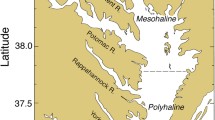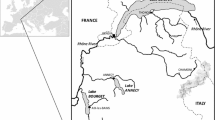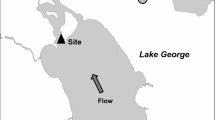Abstract
Lake Maggiore has reached a stable oligotrophic status after a recovery process from mesotrophy that began in the early 1980s. However, the most recent phytoplankton and water chemistry data seem to indicate that various changes are taking place, including a slight increase in TP values, and almost regular blooms have occurred since 2005. Meteoclimatic data collected over the last few decades in the Lake Maggiore watershed highlight an increase in the frequency of extreme rainfall events. Here, for the period 2000–2013, we analyse the relationships between the phytoplankton dynamics and selected extreme precipitation events, in order to evaluate the possible role of rainfall in affecting the nutrient availability and phytoplankton dynamics. Among the algal groups, cyanobacteria showed the strongest relationship with the precipitation pattern, particularly on a short-term temporal scale. Our results support the hypothesis that rainfall may lead to a short-term increase in nutrients that stimulate the growth of phytoplankton and the development of blooms in summer, when epilimnetic waters are usually nutrient depleted. The almost regular cyanobacterial blooms recorded in Lake Maggiore since 2005 can be interpreted as a response to changing precipitation patterns and therefore as a sign of climate-induced eutrophication.






Similar content being viewed by others
References
Ambrosetti, W., L. Barbanti & A. Rolla, 2006. The climate of Lago Maggiore area during the last fifty years. Journal of Limnology 65: 1–64.
APHA AWWA WEF, 2012. standard methods for the examination of water and wastewater. American Water Works Association/American Public Works Association/Water Environment Federation.
Baldi, E., 1949. La situation actuelle de la recherche limnologique apres le Congres de Zurich. Revue suisse Hydrologie 11: 637–649.
Becker, V., L. Caputo, J. Ordonez, R. Marcé, J. Armengol, L. O. Crossetti & V. L. M. Huszar, 2010. Driving factors of the phytoplankton functional groups in a deep Mediterranean reservoir. Water Research 44: 3345–3354.
Bouraoui, F., B. Grizzetti, G. Adelsköld, H. Behrendt, I. de Miguel, M. Silgram, S. Gómez, K. Granlund, L. Hoffmann, B. Kronvang, S. Kvaernø, A. Lázár, M. Mimikou, G. Passarella, P. Panagos, H. Reisser, B. Schwarzl, C. Siderius, A. S. Sileika, A. A. M. F. R. Smit, R. Sugrue, M. Vanliedekerke & J. Zaloudik, 2009. Basin characteristics and nutrient losses: the EUROHARP catchment network perspective. Journal of Environmental Monitoring 11: 515–525.
Callieri, C., R. Bertoni, M. Contesini & F. Bertoni, 2014. Lake level fluctuations boost toxic cyanobacterial “oligotrophic blooms”. PLoS ONE 9: e109526. https://doi.org/10.1371/journal.pone.0109526.
Cardille, J., M. T. Coe & J. A. Vano, 2004. Impacts of climate variation and catchment area on water balance and lake hydrologic type in groundwater-dominated systems: A generic lake model. Earth Interactions 8: 1–24.
Carey, C. C., B. W. Ibelings, E. P. Hoffmann, D. P. Hamilton & J. D. Brookes, 2012. Eco-physiological adaptations that favour freshwater cyanobacteria in a changing climate. Water Research 46: 1394–1407.
Ciampittiello, M., C. Dresti & H. Saidi, 2013. Indagini sul bacino imbrifero. Caratteristiche idrologiche—Ricerche sull’evoluzione del Lago Maggiore. Aspetti limnologici. Programma quinquennale 2008–2012. Campagna 2012 e rapporto quinquennale. Commissione Internazionale per la protezione delle acque italo-svizzere pp. 7–13.
de Bernardi, R., G. Giussani, M. Manca & D. Ruggiu, 1988. Long-term dynamics of plankton communities in Lago Maggiore (N. Italy). Verhandlungen internationale Vereinigung Limnologie 23: 729–733.
de Eyto, E., E. Jennings, E. Ryder, K. Sparber, M. Dillane, C. Dalton & R. Poole, 2016. Response of a humic lake ecosystem to an extreme precipitation event: Physical, chemical, and biological implications. Inland Waters 6: 483–498.
Di Cesare, A., E. M. Eckert, M. Rogora & G. Corno, 2017. Rainfall increases the abundance of antibiotic resistance genes within a riverine microbial community. Environmental Pollution 226: 473–478.
Dokulil, M. T., 2014. Impact of climate warming on European inland waters. Inland Waters 4: 27–40.
Dokulil, M. T. & K. Teubner, 2011. Eutrophication and climate change: Present situation and future scenarios. Eutrophication: Causes, Consequences and Control. Springer, New York: 1–16.
Elliott, J. A., 2012. Is the future blue-green? A review of the current model predictions of how climate change could affect pelagic freshwater cyanobacteria. Water Research 46: 1364–1371.
European Environment Agency, 2015. Nutrients in freshwater. https://www.eea.europa.eu/data-and-maps/indicators/nutrients-in-freshwater/nutrients-in-freshwater-assessment-published-6.
Fastner, J., S. Abella, A. Litt, G. Morabito, L. Vörös, K. Pálffy, D. Straile, R. Kümmerlin, D. Matthews, M. G. Phillips & I. Chorus, 2016. Combating cyanobacterial proliferation by avoiding or treating inflows with high P load—experiences from eight case studies. Aquatic Ecology 50: 367–383.
Geraldes, A. M. & M. J. L. Boavida, 2004. Limnological variations of a reservoir during two successive years: One wet, another dry. Lakes and Reservoirs 9: 143–152.
Guilizzoni, P., G. Bonomi, G. Galanti & D. Ruggiu, 1983. Relationship between sedimentary pigments and primary production: evidence from core analyses of twelve Italian lakes. Hydrobiologia 103: 103–106.
Hammer, Ø., D. A. T. Harper & P. D. Ryan, 2001. PAST: Paleontological Statistics Software Package for Education and Data Analysis. Palaeontologia Electronica 4: 1–9.
Hillebrand, H., C.-D. Dürselen, D. Kirschtel, U. Pollingher & T. Zohary, 1999. Biovolume calculation for pelagic and benthic microalgae. Journal of Phycology 35: 403–424.
IPCC, 2015. Climate Change 2014: Synthesis Report. Contribution of Working Groups I, II and III to the Fifth Assessment Report of the Intergovernmental Panel on Climate Change.
James, T. & M. Chimney, 2008. Hurricane effects on a shallow lake ecosystem, Lake Okeechobee, Florida (USA). Fundamental and Applied Limnology 172: 273–287.
Janke, B. D., J. C. Finlay, S. E. Hobbie, L. A. Baker, R. W. Sterner, D. Nidzgorski & B. N. Wilson, 2014. Contrasting influences of stormflow and baseflow pathways on nitrogen and phosphorus export from an urban watershed. Biogeochemistry 121: 209–228.
Lund, J. W. G., C. Kipling & E. D. Le Cren, 1958. The inverted microscope method of estimating algal numbers and the statistical basis of estimations by counting. Hydrobiologia 11: 143–170.
Manca, M. & R. Bertoni, 2014. Seventy five years of limnology at the Istituto Italiano di Idrobiologia in Pallanza. Journal of Limnology 73: 5–19.
Manca, M., A. Calderoni & R. Mosello, 1992. Limnological research in Lago Maggiore: studies on hydrochemistry and plankton. Memorie dell’Istituto Italiano di Idrobiologia 50: 171–200.
Michel, T. J., J. E. Saros, S. J. Interlandi & A. P. Wolfe, 2006. Resource requirements of four freshwater diatom taxa determined by in situ growth bioassays using natural populations from alpine lakes. Hydrobiologia 568: 235–243.
Morabito, G. & A. Pugnetti, 2000. Primary productivity and related variables in the course of the trophic evolution of Lake Maggiore. Verhandlungen Internationale Vereinigung der Limnologie 27: 2934–2937.
Morabito, G., A. Oggioni & M. Austoni, 2012. Resource ratio and human impact: How diatom assemblages in Lake Maggiore responded to oligotrophication and climatic variability. Hydrobiologia 698: 47–60.
Mosello, R. & D. Ruggiu, 1985. Nutrient load, trophic conditions and restoration prospects of Lake Maggiore. Internationale Revue der Gesamten Hydrobiologie 70: 63–75.
Nõges, P., T. Nõges, M. Ghiani, F. Sena, R. Fresner, M. Friedl & J. Mildner, 2011. Increased nutrient loading and rapid changes in phytoplankton expected with climate change in stratified South European lakes: Sensitivity of lakes with different trophic state and catchment properties. Hydrobiologia 667: 255–270.
Ntegeka, V. & P. Willems, 2008. Trends and multidecadal oscillations in rainfall extremes, based on a more than 100-year time series of 10 min rainfall intensities at Uccle, Belgium. Water Resources Research 44: 7.
O’Farrell, I., A. Vinocur & P. de Tezanos Pinto, 2015. Long-term study of bloom-forming cyanobacteria in a highly fluctuating vegetated floodplain lake: a morpho-functional approach. Hydrobiologia 752: 91–102.
Ockenden, M. C., C. E. Deasy, C. M. W. H. Benskin, K. J. Beven, S. Burke, A. L. Collins, R. Evans, P. D. Falloon, K. J. Forber, K. M. Hiscock, M. J. Hollaway, R. Kahana, C. J. A. Macleod, S. M. Reaney, M. A. Snell, M. L. Villamizar, C. Wearing, P. J. A. Withers, J. G. Zhou & P. M. Haygarth, 2016. Changing climate and nutrient transfers: Evidence from high temporal resolution concentration-flow dynamics in headwater catchments. Science of the Total Environment 548–549: 325–339.
Outram, F. N., C. E. M. Lloyd, J. Jonczyk, C. McW, H. Benskin, F. Grant, M. T. Perks, C. Deasy, S. P. Burke, A. L. Collins, J. Freer, P. M. Haygarth, K. M. Hiscock, P. J. Johnes & A. L. Lovett, 2014. High-frequency monitoring of nitrogen and phosphorus response in three rural catchments to the end of the 2011–2012 drought in England. Hydrology and Earth System Sciences 18: 3429–3448.
Paerl, H. W. & V. J. Paul, 2012. Climate change: links to global expansion of harmful cyanobacteria. Water Research 46: 1349–1363.
Qin, H. P., S. T. Khu & X. Y. Yu, 2010. Spatial variations of storm runoff pollution and their correlation with land-use in a rapidly urbanizing catchment in China. Science of the Total Environment 408: 4613–4623.
Ravera, O. & R. Vollenweider, 1968. Oscillatoria rubescens D.C. as an indicator of Lago Maggiore eutrophication. Schweizerische Zeitschrift Hydrologie 30: 374–380.
Reichwaldt, E. S. & A. Ghadouani, 2012. Effects of rainfall patterns on toxic cyanobacterial blooms in a changing climate: Between simplistic scenarios and complex dynamics. Water Research 46: 1372–1393.
Rogora, M., 2007. Synchronous trends in N–NO3 export from N-saturated river catchments in relation to climate. Biogeochemistry 86: 251–268.
Rogora, M., S. Arisci & A. Marchetto, 2012. The role of nitrogen deposition in the recent nitrate decline in lakes and rivers in Northern Italy. Science of the Total Environment 417–418: 214–223.
Rogora, M., L. Colombo, A. Marchetto, R. Mosello & S. Steingruber, 2016. Temporal and spatial patterns in the chemistry of wet deposition in Southern Alps. Atmospheric Environment 146: 44–54.
Rogora, M., F. Buzzi, C Dresti, B. Leoni, M. Patelli, F. Lepori, R. Mosello, & N. Salmaso, 2018. Climatic effects on vertical mixing and deep-water oxygen content in the subalpine lakes in Italy. Hydrobiologia (this volume)
Ruggiu, D., G. Morabito, P. Panzani & A. Pugnetti, 1998. Trends and relations among basic phytoplankton characteristics in the course of the long-term oligotrophication of Lake Maggiore (Italy). Hydrobiologia 369–370: 243–257.
Saidi, H., M. Ciampittiello, C. Dresti & G. Ghiglieri, 2013. The climatic characteristics of extreme precipitations for short-term intervals in the watershed of Lake Maggiore. Theoretical and Applied Climatology 113: 1–15.
Saidi, H., M. Ciampittiello, C. Dresti & G. Ghiglieri, 2015. Assessment of trends in extreme precipitation events: a case study in Piedmont (North-West Italy). Water Resources Management 29: 63–80.
Salmaso, N. & R. Mosello, 2010. Limnological research in the deep southern subalpine lakes: synthesis, directions and perspectives. Advances in Oceanography and Limnology 1: 29–66.
Schindler, D. W., F. A. J. Armstrong, S. K. Holmgren & G. J. Brunskill, 1971. Eutrophication of Lake 227, Experimental Lakes Area, Northwestern Ontario, by Addition of Phosphate and Nitrate. Journal of the Fisheries Research Board of Canada 28: 1763–1782.
Shimoda, Y., M. E. Azim, G. Perhar, M. Ramin, M. A. Kenney, S. Sadraddini, A. Gudimov & G. B. Arhonditsis, 2011. Our current understanding of lake ecosystem response to climate change: What have we really learned from the north temperate deep lakes? Journal of Great Lakes Research 37: 173–193.
Spyropoulou, A., S. Spatharis, G. Papantoniou & G. Tsirtsis, 2013. Potential response to climate change of a semi-arid coastal ecosystem in eastern Mediterranean. Hydrobiologia 705: 87–99.
Srifa, A., E. J. Phlips, M. F. Cichra & J. C. Hendrickson, 2016. Phytoplankton dynamics in a subtropical lake dominated by cyanobacteria: cyanobacteria “Like it Hot” and sometimes dry. Aquatic Ecology 50: 163–174.
Stutter, M. I., S. J. Langan & R. J. Cooper, 2008. Spatial contributions of diffuse inputs and within-channel processes to the form of stream water phosphorus over storm events. Journal of Hydrology 350: 203–214.
Tapolczai, K., O. Anneville, J. Padisák, N. Salmaso, G. Morabito, T. Zohary, R. D. Tadonléké & F. Rimet, 2015. Occurrence and mass development of Mougeotia spp. (Zygnemataceae) in large, deep lakes. Hydrobiologia 745: 17–29.
Taranu, Z. E., I. Gregory-Eaves, P. R. Leavitt, L. Bunting, T. Buchaca, J. Catalan, I. Domaizon, P. Guilizzoni, A. Lami, S. Mcgowan, H. Moorhouse, G. Morabito, F. R. Pick, M. A. Stevenson, P. L. Thompson & R. D. Vinebrooke, 2015. Acceleration of cyanobacterial dominance in north temperate-subarctic lakes during the Anthropocene. Ecology Letters 18: 375–384.
Weisse, T., B. Groeschl & V. Bergkemper, 2016. Phytoplankton response to short-term temperature and nutrient changes. Limnologica 59: 78–89.
Zhu, M., H. W. Paerl, G. Zhu, T. Wu, W. Li, K. Shi, L. Zhao, Y. Zhang, B. Qin & A. M. Caruso, 2014. The role of tropical cyclones in stimulating cyanobacterial (Microcystis spp.) blooms in hypertrophic Lake Taihu, China. Harmful Algae 39: 310–321.
Znachor, P., E. Zapomělová, K. Řeháková, J. Nedoma & K. Šimek, 2008. The effect of extreme rainfall on summer succession and vertical distribution of phytoplankton in a lacustrine part of a eutrophic reservoir. Aquatic Sciences 70: 77–86.
Acknowledgements
Long-term research on Lake Maggiore has been funded by the International Commission for the Protection of Swiss-Italian Waters (CIPAIS). Investigations on lake Maggiore are also performed within the framework of the LTER (Long Term Ecological Research) Italian network, site “Southern Alpine lakes”, IT08 (http://www.lteritalia.it/). We are indebted to Dr. Aldo Marchetto for his precious help during the revision of the manuscript. We also thank two anonymous reviewers for their helpful comments.
Author information
Authors and Affiliations
Corresponding author
Additional information
This paper is in memory of our beloved friend and colleague, Giuseppe Morabito, who passed away on July 12, 2017.
Guest editors: Nico Salmaso, Orlane Anneville, Dietmar Straile & Pierluigi Viaroli / Large and deep perialpine lakes: ecological functions and resource management
Deceased: Giuseppe Morabito.
Electronic supplementary material
Below is the link to the electronic supplementary material.
Rights and permissions
About this article
Cite this article
Morabito, G., Rogora, M., Austoni, M. et al. Could the extreme meteorological events in Lake Maggiore watershed determine a climate-driven eutrophication process?. Hydrobiologia 824, 163–175 (2018). https://doi.org/10.1007/s10750-018-3549-4
Received:
Revised:
Accepted:
Published:
Issue Date:
DOI: https://doi.org/10.1007/s10750-018-3549-4




